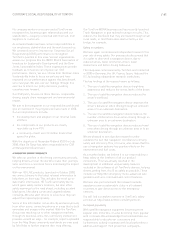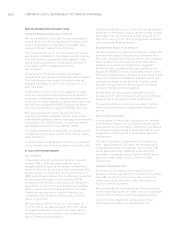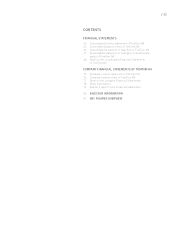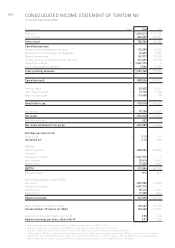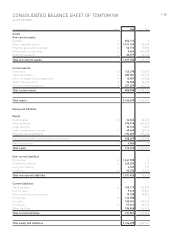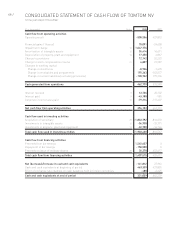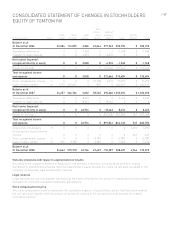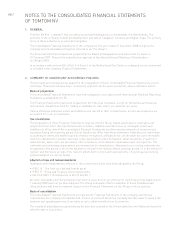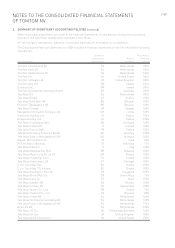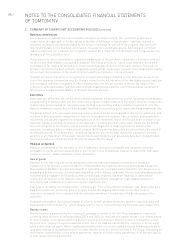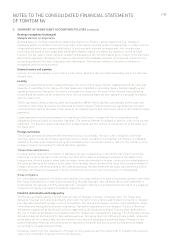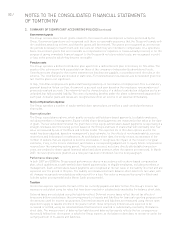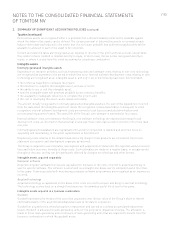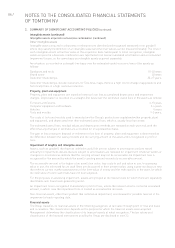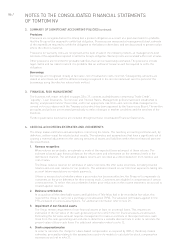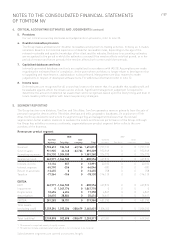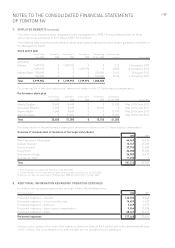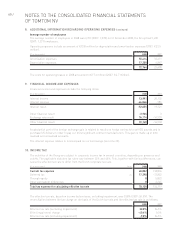TomTom 2008 Annual Report Download - page 53
Download and view the complete annual report
Please find page 53 of the 2008 TomTom annual report below. You can navigate through the pages in the report by either clicking on the pages listed below, or by using the keyword search tool below to find specific information within the annual report./ 51
NOTES TO THE CONSOLIDATED FINANCIAL STATEMENTS
OF TOMTOM NV
2. SUMMARY OF SIGNIFICANT ACCOUNTING POLICIES (continued)
Revenue recognition (continued)
Multiple element arrangements
Bundled sales or multiple-element arrangements require the Group to deliver equipment (e.g. navigation
hardware) and/or a number of services (e.g. traffic information services) under one agreement, or under a series
of agreements which are commercially linked. In such multiple-element arrangements, the consideration
received is allocated to each separately identifiable element, based on relative fair values or on the residual
method. The fair value of each element is determined based on the current market price of each of the elements
when sold separately. The amount of revenues allocated to the hardware element is recognised in line with the
accounting policy for the sale of goods as described above. The revenue relating to the service element is
recognised over the service period.
Interest income and expense
Interest income and expense is accrued on a time basis, based on the principal outstanding and at the effective
interest rate.
Leasing
Leases are classified as finance leases whenever the terms of the lease transfer substantially all the risks and
rewards of ownership to the lessee. All other leases are classified as operating leases. Rentals payable under
operating leases are charged to income on a straight-line basis over the term of the relevant lease. Benefits
received and receivable as an incentive to enter into an operating lease are also spread on a straight-line basis
over the lease term.
The Group leases certain property, plant and equipment. Where the Group has substantially all the risks and
rewards of ownership, the leases are classified as finance leases. Finance leases are capitalised at the lease
commencement date at the lower of fair value of the leased property and the present value of the minimum lease
payments.
Lease payments are allocated between the liability and the finance charge with the corresponding rental
obligations being included in long-term liabilities. The interest element is charged to finance costs in the income
statement. The property, plant and equipment is depreciated over the shorter of the useful life of the asset and
the lease term.
Foreign currencies
The Group’s primary activities are denominated in euros. Accordingly, the euro is the company’s functional
currency, which is also the Group’s reporting currency. Items included in the financial information of individual
entities in the Group are measured using the individual entity’s functional currency, which is the currency of the
primary economic environment in which the entity operates.
Transactions and balances
In preparing the financial information of individual entities, transactions in currencies other than this entity’s
functional currency (foreign currencies) are recorded at the rates of exchange prevailing on the dates of the
transactions. At each balance sheet date, monetary items denominated in foreign currencies are retranslated at
the rates prevailing at the balance sheet date. Non-monetary items carried at fair value that are denominated in
foreign currencies are retranslated at the rates prevailing at the date when the fair value was determined. Non-
monetary items that are measured in terms of historical cost in a foreign currency are not retranslated.
Group companies
For consolidation purposes, the assets and liabilities of foreign entities that have a functional currency other than
the Group’s presentation currency are translated at the year-end spot rate, whereas the income statement is
translated at the average monthly exchange rate. Translation differences arising thereon are taken to a separate
component of Equity (cumulative translation adjustment).
Financial instruments and hedge policy
The Group’s activities expose it to the financial risks of changes in foreign exchange rates. The Group uses
derivative financial instruments (primarily short-term foreign currency option and forward contracts) to manage
the risks associated with foreign currency fluctuations. The Group only hedges currency risks relating to certain
committed and anticipated transaction exposures. Translation exposures are not hedged. The use of financial
derivatives is governed by the Group’s policies, approved by the Supervisory Board. These written principles on
the use of financial derivatives are consistent with the Group’s risk management strategy. The Group does not use
derivative financial instruments for speculative purposes. Derivative financial instruments are initially measured
at fair value on the contract date and are marked to fair value at subsequent reporting dates. Changes in fair
value of derivative financial instruments are recognised in the profit and loss account as they arise as hedge
accounting is not applied by the Group.
Exchange results from the translation of foreign currency balances and the settlement of forward contracts and
options are included in financial income and expenses.


